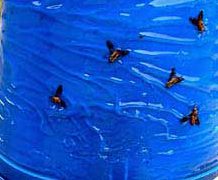
by Larry Williams | Jun 9, 2022
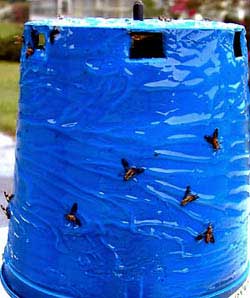
Deer fly trap. Photo credit: Russ Mizell
Recently, I’ve been asked about a deer fly trapping method that I wrote about a number of years ago. So, here it is. This aggravating insect is active now.
Deer flies, which are in the horsefly family, are annoying as they repeatedly and persistently dive for their victims until they inflict a painful bite.
Dr. Russ Mizell, now retired UF/IFAS Extension entomologist, experimented with a method to trap this insect. Mizell wanted to identify the optimum shape, size, color and speed to attract deer flies. If successful, he could temporarily remove a deer fly population long enough to enjoy an outdoor gathering without being bothered by deer flies.
Mizell said he started the research as a high school science project with his son but “it got so interesting, I just kept doing it.”
Deer flies wait for prey to walk before attacking. So, they are highly attracted to movement.
With this in mind, Mizell and his son decided the best way to snare deer flies was to “troll” for them from a slow-moving vehicle. Working in spring and summer when deer flies are most prominent, they set out to discover what kind of trap worked best.
They built a test platform on the hood of their vehicle that could troll seven different shapes at once. They ambled along in deer fly-infested countryside for set periods of one to five minutes, testing pyramids, squares, balloons, plant containers and other shapes, all coated with Tanglefoot (commercially available sticky spray for insects), then counting immobilized prey. They tried black, tan, blue and shapes of other colors suspended from various heights.
The trap that enticed the most deer flies proved to be a 6-inch flowerpot painted bright blue and coated with Tanglefoot. This trap captured as many as 30 deer flies in a one-minute test. It worked best when suspended three to six feet above the ground and trolled no faster than 10 feet per second or about 7 miles per hour.
The traps are remarkably effective, Mizell said. “Many times, after running the traps through an area, we found there were no deer flies left,” he said. “You trap them out for a short period until they repopulate the area.”
The traps also work when attached to a baseball cap and trolled by the hat’s wearer. But instead of attaching a flowerpot to your cap, you could attach a blue drink cup painted with Tanglefoot.
Despite its effectiveness, its aesthetic appeal leaves something to be desired.
For more information including instructions and pictures of how to make a deer fly trap visit the below site. http://entomology.ifas.ufl.edu/pestalert/deerfly.htm
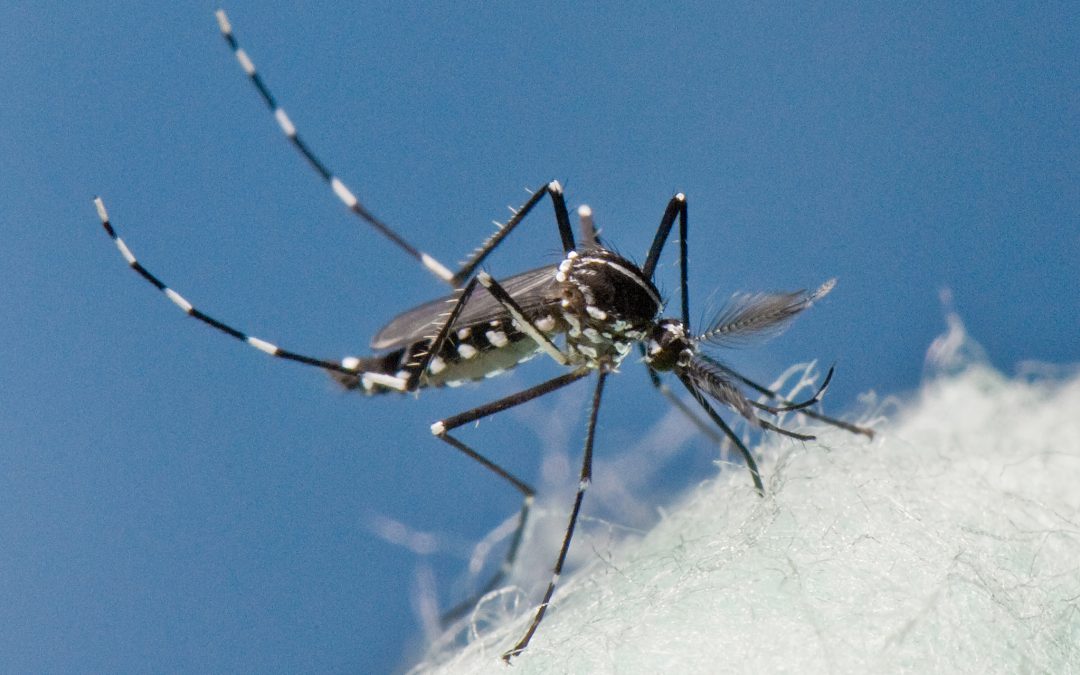
by Danielle S. Williams | May 12, 2022
Mosquitoes are a pesky nuisance we’re all too familiar with, especially as we move into the summer months. Their presence can certainly make being outdoors undesirable. Not only are they a blood-sucking nuisance but they also carry and can transmit many diseases to humans. Mosquito-borne diseases of public health concern in Florida include St. Louis encephalitis, eastern equine encephalitis, West Nile virus encephalitis, dengue, and Zika. While it can be difficult to eliminate mosquito populations completely, there are steps we can all take to protect ourselves and to prevent our landscape from becoming a major breeding ground for mosquitos.
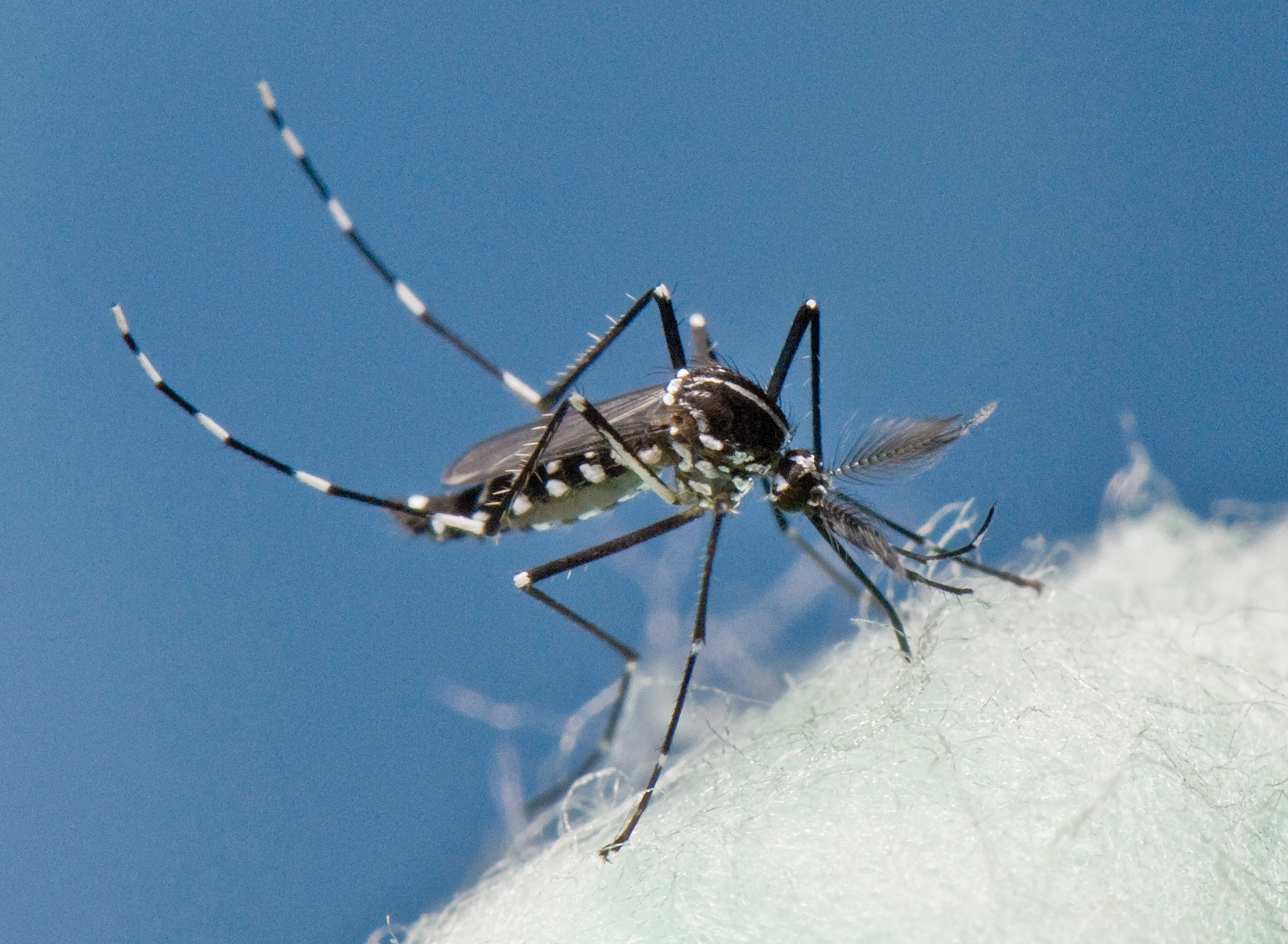
Asian Tiger Mosquito. Photo Credit: James Newman. UF/IFAS Photo.
Source Reduction
One way to keep mosquito populations down is to prevent the landscape from being a breeding ground for them. Many species of mosquitoes require standing water to lay their eggs; therefore, eliminating standing water can help keep populations low. Mosquitoes can develop in a variety of water-holding containers such as flowerpots, birdbaths, pet dishes, tree holes, bamboo trunks, and many others. It is important to:
- Drain water from garbage cans, gutters, buckets, coolers, or any other containers where water is collected
- Discard any old tires, bottles, broken appliances, or items not being used that could potentially hold water
- Change water in birdbaths and/or outdoor pet dishes once or twice a week

Mosquito larvae. UF/IFAS File Photo
For areas such as ornamental ponds or water gardens, aeration or stocking them with mosquitofish (Gambusia species) can also help to keep mosquito populations down. The small fish will feed on the mosquito larvae and add movement to the water. They are most effective in small ponds with no other fish present.
For other areas with standing water that cannot be drained, such as rain barrels or ornamental ponds, products containing Bacillus thuringiensis israelensis (Bti) are effective in controlling mosquito larvae. Products containing Bti come in the form of granules or “dunks”, which look like miniature donuts. These Bti products are considered a form of biological control as it is a naturally occurring bacteria that is specific to mosquito, blackfly, and fungus gnat larvae. Therefore, Bti products are not harmful to fish, waterfowl, pets or humans when used according to label directions.
Protective Clothing and Repellents
The most effective way to protect yourself from mosquito bites is to avoid infested areas, wear protective clothing, and wear insect repellent when outdoors. There are several repellents that are currently available such as DEET, picaridin, and IR3535, or plant derived chemicals such as citronella and oil of lemon eucalyptus.
It is important to read the label before applying mosquito repellent and to remember that there are different recommendations for frequency of application for different products. Below is a table comparison of products based upon University of Florida research.
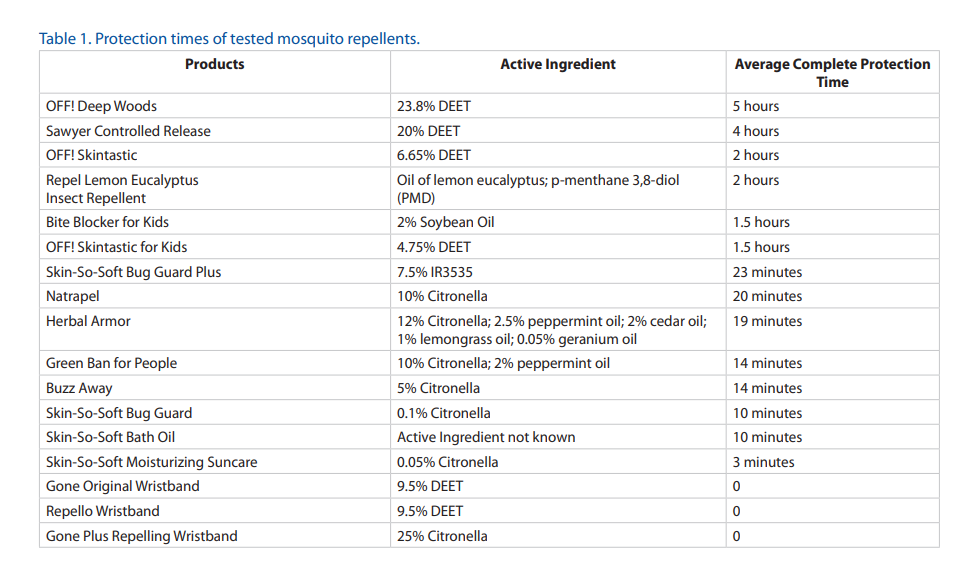
Table from UF/IFAS Publication: Mosquito Repellents
For more in-depth information on selecting mosquito repellents, please visit the UF/IFAS Publication: Mosquito Repellents.
For more information about mosquitos, please visit:

by Joshua Criss | Apr 20, 2022
Getting your landscape set up in the spring is an in-depth process. Trees are pruned, soil amended, and the plantings have been accomplished. Now you have exactly the look you want. It would be easy to sit back, open a beverage of your choice, and watch it all come together. Don’t get comfortable just yet, there is a group of pests eyeing your plants. Insects come in many forms, looking to make a meal from your hard work. Do not fear though, there is a straightforward way to protect yourself from these creatures. Integrated pest management is a system of four control approaches designed to mitigate pest damage while minimizing impact on the environment.
Identification is Key
Before any of these steps may begin pests must be identified. This starts with scouting your landscape via visual inspection. Insects leave signs of their presence wherever they visit. Be sure to inspect every part of your plants including the underside of leaves. Here is where you will find insect eggs or frass (excrement) which are tell-tale signs of activity. Once discovered, you need to identify your specific pest. Insects are identified by their mouth parts when assessing plant damage. Chewing insects remove leaf material (think caterpillars and grasshoppers). Speckled leaves of brown and yellow is a symptom of piercing/sucking insects such as aphids. Other times you may only find damage after the fact where black leaves turn out to be covered in sooty mold. The sooty mold grows on the excreted honeydew of aphids, whiteflies. Once identified, it is up to you to decide if the level of damage is worth it and how you would like to approach limiting the damage.

Sooty mold on Ixora Photo Credits: UF/IFAS Kim Gabel
The First Three
The first strategy is cultural control wherein you optimize the environment in which your plant grows. Improved drainage and removal of plants susceptible to insect attack are excellent examples. You should also look into the lifecycle of insect pests to remove anything that will provide habitat. The next control is mechanical. This methodology is the most work intensive but comes with the least environmental impact as insects will be removed by hand. Biological control is like mechanical control except that removal of the pest is left to natural predators. There are many, but birds and lady beetles are best known. Creating habitat for these will help keep insect populations to an acceptable level with the bonus of falling into Florida friendly landscaping philosophies.
Chemicals are Not the Bad Guy
Chemical control is the final approach. Some may be surprised to find this here, but it is effective. With the above in place, you may find there are still insect issues. Chemicals will be your next step but do not feel put off by this approach. Research the best products for your situation and follow the instructions on the label to the letter. The label is designed to reduce risk to you and the environment while providing effective pest control.
Insect pests have plagued gardeners since the first person intentionally planted anything. Controlling these pests using a multipronged approach is the optimal way to reduce damage to your plants while minimizing environmental impact. Following the methodology in this post will bring a pest free landscape that you and your family will enjoy. For more information on integrated pest management, see these Ask IFAS documents, or contact your local extension agent for additional information on this and any topic regarding your gardens and more.

by Matt Lollar | Mar 24, 2022

Written by: Donna Arnold, University of Florida/IFAS Extension – Gadsden County
Have you ever noticed mounds of dirt popping up on your lawn, in your cattle pastures, and other places? You just might be experiencing an ant invasion. The Red Imported Fire Ant, (referred to hereafter as RIFA) came from South America in the early 1900s through the port of Mobile, Alabama. Today, they have spread across the US and have become a serious pest causing significant social, environmental, and economic impacts. RIFA mounds can be seen in well-manicured landscapes, but also can nest around tree roots and stumps, as well as under pavement, buildings, and indoor areas. Although RIFA do prey on flea larvae, chinch bugs, cockroach eggs, ticks and other pests, however the problems they create usually outweigh their benefits.
Lifecycle/description.

Red Imported Fire Ant. Photo Credit: University of Florida/IFAS
Size determines the lifespan of RIFA workers. Minor workers may live 30 to 60 days, media workers 60 to 90 days, major workers 90 to 180 days, and queens may live two to six years. Complete lifecycle from egg to adult takes between 22 and 38 days. RIFA are 1/8” to 1/4” long and reddish-brown or black in color.
RIFA usually respond rapidly and aggressively when disturbed. They clamp onto their victims with powerful jaws and sting repeatedly while injecting painful venom. The stings cause a burning sensation and itching blisters that can become infected. Although very uncommon, in severe cases, the stings can produce shock or cause death.
Where one can find RIFA
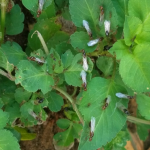
Winged alates preparing for nuptial flight. Photo Credit: Donna Arnold, University of Florida/IFAS Extension – Gadsden County
RIFA frequently invade home lawns, school yards, athletic fields, golf courses, parks, and other recreational areas. Additionally, electrical equipment and utility housing, home gardens, compost piles, mulched flowerbeds, pavement cracks, and the perimeter of bodies of water must all be considered when choosing a method of control.
Management
Two approaches can be taken to effectively manage RIFA.
- Single mound treatments
- Area-wide broadcast applications
Six methods of single mound treatment are available.
Mound Drenches. Large volumes of liquid toxic to ants are poured over a mound. Liquids can range from using several gallons of hot water to insecticides mixed with several gallons of water. This method may not reach the queen, therefore, not preventing colony elimination.
Surface Dusts. Similar to mound drenches, a dust or granular insecticide is applied over the top of the mound and then watered into the soil.
Mound Injections. The use of insecticides that may be pressurized and injected into a mound. Often this method is more expensive, but more effective, than mound drenches; however, more time may be required for this method.
Baits. Baits can be used for both individual mound and broadcast applications. A small amount of the bait is sprinkled around the mound and the ants then forage and bring the bait back to the colony to feed on. This method is slower acting, but more effective than drenching, dusting, or fumigating a mound because the workers will feed the bait to the queen and brood, thus gaining effective control of the colony.
Mechanical Control. Certain mechanical and electrical devices are on the market for controlling fire ants, but the efficacy has not been documented.
Home Remedies. Many homeowners will choose to pour boiling water or ignite flammable liquids over a mound. While these methods may bring about control, they are not recommended because they are both very dangerous, not only to humans, but also to the environment. Several other myths often circulate by the media or by way of word of mouth, often times these methods are anecdotal.
Area-wide broadcast applications
Currently, there are only a few products available for broadcast treatment of large areas. These products are either granular insecticides or baits composed of soybean oil and toxicant on a corn grit carrier. These granules are broadcast over a large area and are carried to the colony and fed to nestmates and the queen. This is a very effective application but does present problems because (1) ants may not find it, (2) do not feed upon the bait, and (3) some baits are light sensitive (as with hydramethylnon) and may inactivate before discovery by the ants. Reinfestation of any treated area, whether by broadcast treatment or individual mound treatment may occur.
As a result, other methods such as Biological Control is widely used to mitigate control of the RIFA.
Supporting information for this article can be found in the UF/IFAS EDIS publications (Managing Imported Fire Ants in Urban Areas) visit https://edis.ifas.ufl.edu/publication/lh059 and Red Imported Fire Ant, Solenopsis Invicta Buren (Insecta: Hymenoptera: Formicidae: Myrmicinae) https://edis.ifas.ufl.edu/publication/IN352.

by Matt Lollar | Nov 22, 2021
Houseplants can soften up the interior of your home and help clean the air. They can also supplement your holiday decorations and help create stunning focal points. To help determine what plants do best under certain conditions and to give pointers on plant care, this month’s Gardening in the Panhandle LIVE! was all about houseplants.
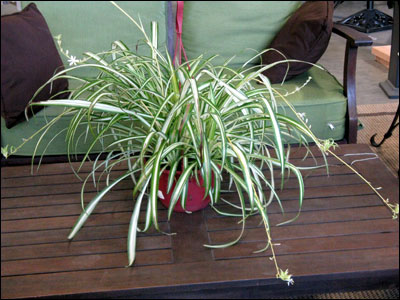
A spider plant on a coffee table. Photo Credit: University of Florida/IFAS
Environmental Conditions for Houseplants
Unless you live in a glass house, you’ll probably want to choose houseplants that do well in low light conditions. A guide for what light level different houseplants prefer can be found on the Gardening Solutions Light for Houseplants page. This page also provides useful tips on supplemental lighting.
Some houseplants are better at cleaning the air than others. A list of houseplants that do a good job improving indoor air quality can be found on the Gardening Solutions Houseplants That Clean the Air page.
The best way to determine if your houseplants need water is your own green thumb or whatever finger you choose to stick in the potting mix, but for some interesting information on outdoor soil moisture meters check out this informative publication on soil moisture sensors.
Houseplants need a good quality, well-drained potting mix to thrive. Tips on selecting a potting mix can be found on the Gardening Solutions Container Media page.
Houseplant Pests
One of the best ways to rid houseplants of insect pests is to set the plants outside for a few days and let the pests move on. For some information on pest control products in and around the home check out the publication Natural Products for Managing Landscape and Garden Pests in Florida.
Fungus gnats are mainly a nuisance, but some species can feed on living plant tissue. Darkwinged fungus gnats are known to feed on ferns, orchids, and geraniums.
Houseplant Propagation
One way to increase your houseplant population and save a few dollars is to propagate your own plants. The University of Florida/IFAS created the Plant Propagation Glossary to help with any propagation questions you may have.
Air layering is a propagation technique that not only allows the prospective plant to thrive from the nutrients of the mother plant, but it also saves space.

A moth orchid (Phalaenopsis spp.) outdoors. Photo Credit: University of Florida/IFAS
Specific Species Info
Orchids in the genus Phalaenopsis are easier to care for than other genera of orchids. The American Orchid Society provides some great tips on caring for orchids indoors. Some people choose to water their orchids with ice cubes. The Ohio State University has a publication that provides some more insight on watering Phalaenopsis orchids with ice cubes.
A lot of cacti do well indoors. A popular cactus during the holiday season is Christmas cactus. Christmas cactus have interesting foliage, but their blooms are what people want to see. Some tips on getting your Christmas cactus to bloom on time and general care information can be found in this Christmas Cactus Preparation fact sheet.
Have you ever wanted to grow fruit trees indoors or do you want some tips on bringing containerized fruit trees indoors for the winter? The Growing Fruit Crops in Containers publication provides some good tips on growing fruit trees indoors.
Unless you have a house with a lot of windows or a sunroom, plumeria don’t make the best houseplants. They need at least six hours of sunlight per day and need to be at least three years old to bloom. If you are interested in propagating plumeria, then check out this publication on propagating plumeria from cuttings.















